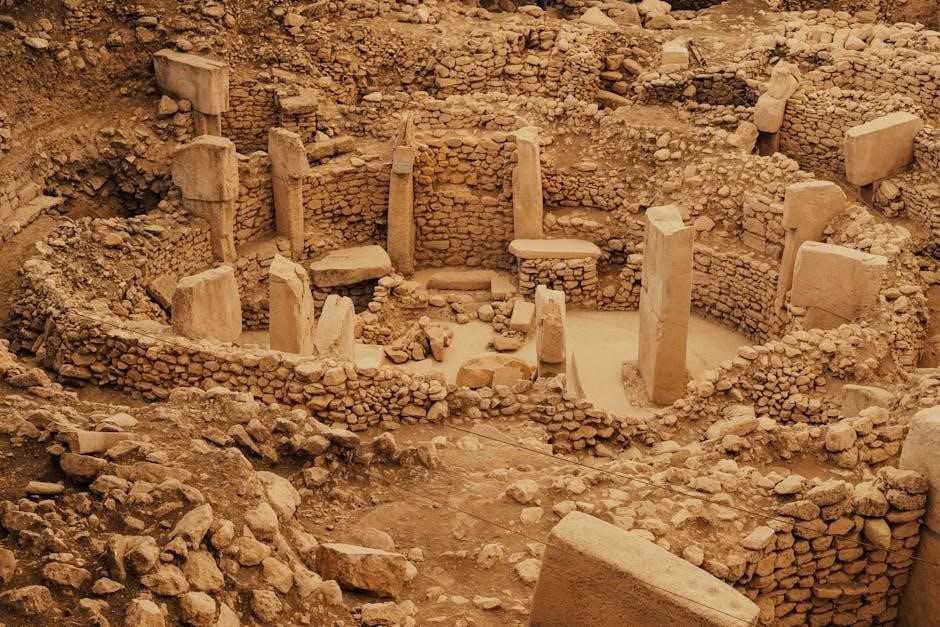
How to Save a Detailed Map as a PDF
To save a detailed map as a PDF, open the desired map in your browser or app․ Use the print function and select “Save as PDF” to create a high-quality file for offline use․
Saving a detailed map as a PDF is a practical way to access geographic information offline․ Whether for travel, research, or professional use, PDF maps offer high-quality visuals and portability․ Popular services like Google Maps and AllTrails allow users to download maps with precise details․ Customization options, such as adding markers or layers, enhance usability․ Additionally, specialized tools like MapQuest and GIS software provide advanced features for creating tailored PDF maps․ This method ensures that maps remain legible and functional without internet connectivity, making them ideal for various applications․ By following simple steps, anyone can save detailed maps in PDF format efficiently․
Why Convert Maps to PDF Format
Converting maps to PDF format offers numerous benefits, including portability and offline accessibility․ PDFs preserve map details and layout, ensuring high-quality visuals on any device․ This format is ideal for sharing, embedding in documents, or printing․ Additionally, PDFs are universally compatible, making them easy to view without specialized software․ For professionals, PDF maps can be integrated into reports or presentations seamlessly․ They also support customization, such as adding annotations or layers, enhancing their utility․ By converting maps to PDF, users can ensure their geographic data remains accessible and well-formatted for various applications, making it a practical choice for both personal and professional use․
Using Google Maps to Save a Detailed Map as PDF
Access Google Maps, adjust the view, and click the print button․ Choose “Save as PDF” to download the map, ensuring high-quality details are preserved for offline use․
Steps to Save a Google Map as PDF
To save a Google Map as a PDF, first ensure the desired area is displayed․ Click the print icon, select “Save as PDF,” and choose your printer settings․ Adjust the map size and orientation if needed, then click “Save” to download the PDF file․ This method allows you to capture detailed maps for offline use, ensuring all markers and labels are included․ The PDF will retain the map’s high-quality visuals, making it ideal for sharing or printing․ This process is straightforward and quick, providing a reliable way to store maps digitally․
Customizing the Map Before Saving
Before saving your map as a PDF, customize it by adding markers, labels, and layers to enhance clarity․ Adjust the zoom level to focus on specific areas and remove unnecessary details․ Include points of interest, routes, or custom data to make the map more informative․ Use tools like MapQuest or AllTrails to personalize your map further․ Ensure the layout is visually appealing by adjusting colors and fonts․ These customizations help create a tailored map that meets your needs, making it easier to interpret and share․ By refining the map before saving, you ensure the PDF is precise and ready for professional or personal use․
Using Third-Party Tools with Google Maps
Third-party tools like UPDF, MapQuest, and AllTrails can enhance your Google Maps experience․ UPDF allows direct conversion of Google Maps to PDF, preserving details like routes and markers․ MapQuest enables adding custom markers and layers, which can then be exported as PDF․ AllTrails is ideal for outdoor maps, offering PDF downloads of trails and routes․ Framacarte provides advanced customization options, such as annotations and data imports, before saving as PDF․ These tools complement Google Maps by offering features like batch processing, high-resolution exports, and specialized map designs․ They are particularly useful for creating detailed, professional-grade PDFs tailored to specific needs like presentations or travel guides․
Other Online Map Services for PDF Conversion

Other online services like MapQuest and AllTrails offer detailed maps for PDF conversion․ These platforms provide customization options, high-resolution exports, and easy integration into documents or websites․
MapQuest and Similar Platforms
MapQuest and similar platforms offer intuitive tools for saving detailed maps as PDFs․ Users can customize maps by adding markers, layers, and specific routes before exporting them․ These platforms provide high-resolution options, ensuring clarity in the final PDF․ Additionally, they allow easy integration of maps into websites or documents, making them ideal for professional use․ Some services also support batch processing, enabling users to convert multiple maps simultaneously․ For offline use, certain platforms offer the ability to download maps directly as PDFs, which is particularly useful for travelers․ Overall, MapQuest and similar services are versatile solutions for creating and sharing detailed maps in PDF format efficiently․
Using AllTrails for Detailed Outdoor Maps
AllTrails is a fantastic resource for outdoor enthusiasts, offering detailed maps that can be easily saved as PDFs․ Users can browse trails, customize maps with waypoints, and download them for offline use․ The platform supports PDF exports, ensuring that maps remain high-quality and georeferenced․ This feature is especially useful for hikers and explorers who need accurate terrain information without internet access․ Additionally, AllTrails allows users to print maps or share them directly from the website․ By converting trails to PDF, users can plan routes efficiently and navigate confidently in remote areas․ This makes AllTrails a go-to tool for anyone seeking detailed outdoor maps in a portable format․
Specialized Map Services for PDF Export
Specialized map services like Mapbox, Carto, and IGN Maps offer advanced tools for exporting detailed maps as PDFs․ These platforms provide high-resolution maps with customizable layers, markers, and annotations․ Users can georeference maps, ensuring accuracy for professional use․ Services like AllTrails and MapQuest also support PDF exports, ideal for outdoor enthusiasts․ Additionally, tools like MapChart and d-maps allow users to create and download custom maps in PDF format․ These services cater to diverse needs, from urban planning to trail navigation, making them indispensable for individuals and professionals requiring precise map data in a portable format․ They ensure that maps remain detailed and usable offline, enhancing productivity and accessibility․

Offline Maps and PDF Conversion
Download detailed offline maps via services like Google Maps or third-party apps․ Use print functions or tools like UPDF to convert saved maps into PDFs for easy offline access and sharing;
Downloading Offline Maps from Google Maps
To download offline maps from Google Maps, open the app and select the area you wish to save․ Zoom in or out to adjust the map size, then tap the “Download” button․ Once downloaded, use the print function to convert the offline map to a PDF․ Ensure the map is fully loaded before printing to include all details․ You can also use third-party tools like UPDF for conversion․ This method allows you to access detailed maps offline and share them easily․ The process ensures high-quality maps are saved for future reference or sharing․
Converting Offline Maps to PDF Format
To convert an offline map to PDF, open the downloaded map in Google Maps․ Use the print function and select “Save as PDF” to capture the map․ Ensure the map is fully loaded and zoomed appropriately for clarity․ On mobile devices, check for a “Print to PDF” option․ For higher quality, adjust the zoom level before converting․ Consider using third-party tools like UPDF for better formatting․ Be mindful of file size due to map detail․ Verify the PDF for accuracy and completeness after conversion․ This method ensures detailed maps are accessible offline and can be easily shared or archived․
Using Mobile Apps for Offline Map Conversion
Mobile apps simplify converting offline maps to PDF․ Open the map in Google Maps or a third-party app like AllTrails․ Use the app’s print or export feature to save as PDF․ Ensure the map is fully downloaded and adjust the zoom level for clarity․ Some apps offer direct PDF export, while others may require screenshot or print options․ Check settings for PDF quality and file size․ After exporting, review the PDF for accuracy․ This method ensures detailed maps are accessible offline and easily shared․ Use apps like UPDF or ArcGIS for advanced features, enabling professional-grade PDF conversion for maps․

Customizing and Enhancing Your Map
Add markers, labels, and layers to your map for personalization․ Use tools like MapChart or Canva to enhance visuals and data․ Export your customized map as a PDF․
Adding Markers and Labels

Enhance your map by adding markers and labels to highlight key locations․ Use tools like Google My Maps or MapChart to pinpoint destinations and add descriptive text․ For example, mark hotels, landmarks, or meeting points with distinct icons and labels․ This feature is particularly useful for creating travel itineraries or event maps․ Additionally, platforms like AllTrails allow you to annotate outdoor routes, making it easier to share detailed plans․ These markers and labels can then be included when exporting your map as a PDF, ensuring all important details are preserved for offline use or printing․
Including Additional Data and Layers
Enhance your detailed map by incorporating additional data and layers to provide deeper context․ Import statistical data in formats like ․xls or ․csv to create thematic maps, highlighting trends or patterns․ Platforms like MapChart and Canva offer tools to add custom layers, such as colored regions or annotations․ For outdoor maps, services like AllTrails allow adding trails, waypoints, and elevation data․ These layers can be included when exporting your map as a PDF, ensuring all information is preserved․ This feature is ideal for professional use, such as reports or presentations, where detailed, data-rich maps are essential for clear communication and analysis․
Using Map Editing Software
Map editing software offers advanced tools to customize and refine your detailed maps before saving them as PDFs․ Platforms like Mapcreator and ArcGIS allow you to add markers, custom layers, and annotations, ensuring your map meets specific needs․ Tools like Canva provide templates for aesthetic enhancements, while GIS software enables precise adjustments for professional-grade outputs․ These programs often support exports in multiple formats, including high-resolution PDFs․ By leveraging these features, you can create tailored maps with embedded data, making them more informative and visually appealing for both personal and professional use․

Historical and Specialized Maps
Access historical maps online, including maritime and railway charts․ Specialized maps cater to specific needs, allowing users to download detailed PDFs for reference or printing purposes․
Accessing Historical Maps Online
Historical maps are available on platforms like Geoportail and specialized archives․ Users can explore centuries-old maps, including maritime charts and railway plans․ These sites offer free access to detailed cartographic collections․ To download, simply search, select, and use the right-click “save as” option․ Many platforms provide high-resolution PDFs for printing or offline use․ Additionally, sites like IGN and Visorando offer historical topographic maps, ideal for research or educational purposes․ Customization tools allow users to add markers or layers, enhancing the map’s utility․ These resources are invaluable for historians, educators, and enthusiasts seeking detailed historical cartography․
Converting Historical Maps to PDF
Converting historical maps to PDF is straightforward using tools like UPDF or browser extensions․ Open the map, use the print function, and select “Save as PDF․” Ensure the map is zoomed to desired detail․ Advanced options like MapCreator allow exporting maps in SVG or PDF formats․ For georeferenced maps, use GIS software to maintain accuracy․ Some platforms, such as AllTrails, enable direct PDF downloads․ Always check resolution settings for clarity․ These methods ensure historical maps are preserved in high quality for research or presentation․ Utilize these tools to convert and save historical maps efficiently for future reference․
Specialized Maps for Specific Needs
Specialized maps cater to unique requirements, offering detailed solutions for industries like agriculture, urban planning, or outdoor activities․ Platforms like AllTrails provide PDF maps for hiking trails, while MapQuest offers custom routes․ Tools like MapCreator allow users to design personalized maps, adding layers and data for specific needs․ For professionals, GIS software enables high-quality PDF exports with georeferencing․ These tailored maps ensure precise information, meeting the demands of various fields․ Whether for environmental studies or logistics, specialized maps in PDF format provide clarity and functionality, making them indispensable for targeted applications and detailed planning․ Their versatility ensures they meet diverse user needs effectively․

Integrating Maps into Websites and Documents
To save a detailed map as a PDF, follow these organized steps:

Open Google Maps: Navigate to Google Maps in your web browser and locate the area you wish to save․
Adjust the View: Zoom in or out to ensure the map area you want is fully visible on the screen․
Access Print Function: Use the browser’s print function by pressing `Ctrl + P` (Windows) or `Cmd + P` (Mac)․ This opens the print dialog․

Select Save as PDF: In the print dialog, choose the option to “Save as PDF” instead of printing․ This option is usually found under the destination or print options․
Adjust Settings: Modify any settings like layout or quality to ensure the map is clear and well-formatted in the PDF․
Save the PDF: Choose a location on your computer to save the PDF file and click “Save․”
This method provides a straightforward way to save a detailed map as a PDF using your browser’s built-in functionality․
Embedding Maps in Web Pages
Exporting Maps for Professional Use
Exporting maps for professional use requires high-resolution output to ensure clarity in presentations or reports․ Tools like Google Maps allow saving as PDF, preserving details for professional contexts․ Use GIS software for advanced customization, such as adding layers or data overlays․ For web integration, export maps in formats like SVG or PNG for scalability․ Ensure compliance with licensing terms to avoid copyright issues․ Additionally, use specialized platforms like Mapbox or ArcGIS for tailored exports, enabling precise control over the map’s content and design․ This ensures the final product meets professional standards and effectively communicates geographical data to your audience․
Using APIs for Advanced Map Integration
APIs enable advanced map integration by providing programmatic access to high-resolution map data․ Developers can use APIs like Google Maps or Mapbox to fetch detailed maps and integrate them into custom applications․ These tools allow for dynamic elements, such as real-time data overlays or user-specific markers, to be included in the map before exporting it as a PDF․ Additionally, APIs support batch processing, making it efficient to generate multiple maps in a single workflow․ For professional use, APIs ensure scalability and consistency, enabling precise control over the final output format and quality․ This method is ideal for creating tailored, high-quality PDF maps for presentations, reports, or web applications․
Advanced Techniques for Map Conversion
Utilize GIS software for high-quality maps and batch processing to optimize PDFs for various devices, ensuring precise and efficient map conversion for professional and detailed outputs․
Using GIS Software for High-Quality PDFs
GIS software like ArcGIS or QGIS enables advanced map conversion, offering precise control over georeferencing and layer customization․ These tools allow users to export maps as high-resolution PDFs, preserving spatial accuracy and detail․ By utilizing georeferenced data, maps retain their coordinate systems, ensuring professional-grade outputs․ Additionally, GIS software supports batch processing, enabling efficient conversion of multiple maps into PDF format․ This method is ideal for creating detailed, scalable maps for presentations, reports, or archival purposes․ The ability to customize symbols, annotations, and layouts further enhances the quality of the final PDF, making GIS software a powerful solution for advanced map conversion needs․
Batch Processing Multiple Maps
Batch processing allows users to convert multiple maps into PDFs efficiently, saving time and effort․ Tools like MapCreator and ArcGIS support this feature, enabling the export of several maps in one go․ This method is particularly useful for projects requiring uniform formatting across numerous maps․ By automating the process, users ensure consistency in output quality and formatting․ Additionally, batch processing can be customized to include specific layers, annotations, and resolutions, making it ideal for large-scale mapping projects․ This approach streamlines workflows, especially for professionals handling extensive geographical data, ensuring quick and reliable PDF conversion for multiple maps simultaneously․
Optimizing PDFs for Different Devices
Optimizing PDFs for various devices ensures compatibility and quality across different screens․ Start by adjusting resolution and file size, compressing images for mobile devices while maintaining clarity․ Use tools like Adobe Acrobat or online optimizers to reduce file size without losing map detail․ Ensure maps are zoomable on mobile devices and properly formatted for larger screens․ Save settings as presets for future use, tailoring file compression and resolution based on the intended device․ This approach ensures maps are accessible and visually consistent, whether viewed on smartphones, tablets, or desktops, enhancing user experience across all platforms․

Saving detailed maps as PDFs is straightforward using print functions or third-party tools․ Optimize for devices, ensure clarity, and use offline or share easily with these methods․
Final Tips for Saving Maps as PDF
Always zoom in on the area of interest for maximum detail before saving․ Use high-resolution settings to ensure clarity․ Check the print preview to adjust layout and content․ Verify the PDF after saving to ensure all elements are visible․ Consider using tools like UPDF for additional editing or compression․ For offline use, ensure maps are downloaded fully before conversion․ Highlighting key areas with markers or labels can enhance readability․ Experiment with different formats like PNG or SVG before converting to PDF for optimal results․ Regularly update your software and extensions to access the latest features for map conversion․ This ensures your PDF files are professional and ready for sharing or printing․